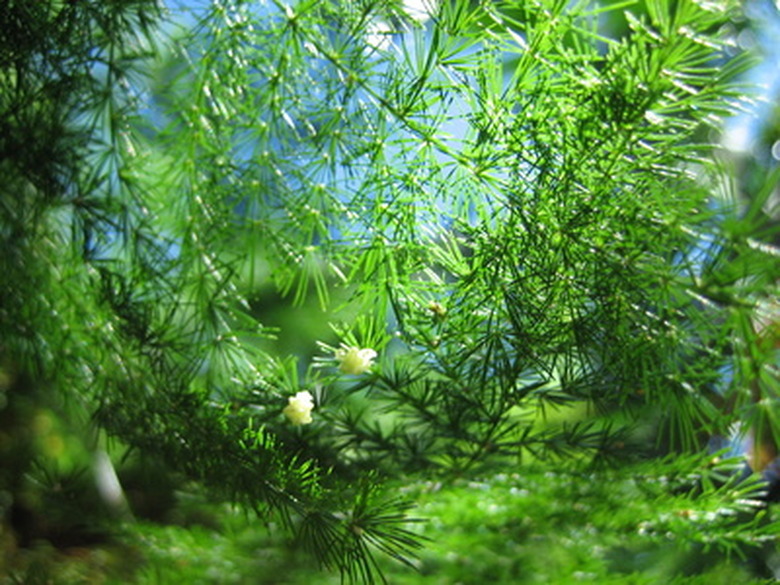Types Of Asparagus Fern
Native to southern Africa, three species of plants are called "asparagus ferns." Not true ferns, they are members of the lily family, Liliaceae. Grow them as houseplants or outdoors in places where there are no winter frosts and the soil is moist, well-draining and in partial-sun to partial-shade locations, where shade is provided from the strongest sun of the day.
Asparagus densiflorus
Perhaps the most widely known "asparagus fern," this species has arching stems with small branches lined in bright green, needle-like leaves. The stems have occasional prickly spines on them. It grows vigorously, forming rounded water-storing bulbs underground. In summer this plant produces tiny white flowers that become pea-sized red berries that are eaten by birds. In subtropical locations like Florida, this species is invasive and regarded a noxious weed.
- Native to southern Africa, three species of plants are called "asparagus ferns."
- In summer this plant produces tiny white flowers that become pea-sized red berries that are eaten by birds.
There are two popular cultivated varieties, or cultivars, of this species. Also called the emerald fern, 'Sprengeri' has arching stems and a loose form, and readily sets fruits that will germinate in the garden. 'Myersii' is called the foxtail fern and has upright stems and rarely flowers or produces fruits, making it less pesky in an outdoor garden setting.
Asparagus scandens
Usually called the climbing or ground asparagus fern, this species has wiry stems that climb or sprawl with fern-like light green leaves arranged in whorls of two or three on the stems. It forms tiny white flowers in summer followed by red berries.
Asparagus setaceus
This plant has a botanical name Asparagus plumosus. It is a bushy plant with frilly, feathery foliage emanating from a cluster of up to 20 stems. As the plant ages, some stems grow longer and twine, with curled spines on the stem to clasp to structures for support. It has tiny white flowers in summer followed by pea-sized purplish-black berries.
- There are two popular cultivated varieties, or cultivars, of this species.
- Also called the emerald fern, 'Sprengeri' has arching stems and a loose form, and readily sets fruits that will germinate in the garden. '
Asparagus Fern?
Plant asparagus ferns outdoors in well-drained, organically enriched soil — amend regular garden soil with peat moss or ground bark. Outdoors in hot climates, asparagus ferns develop their richest green in partial shade — the leaves tend to yellow in dense shade. Though their fleshy roots allow them to admirably weather periods of drought, they shine with regular watering. Most can take a light frost — the surviving roots produce fresh spring growth. It makes an excellent ground cover in even poor soil. " Compacta" is a short, dense variety. Other asparagus ferns include A. cochinchinensis, hardy down to USDA zone 6, with its grassy-leaved foliage clumps. With care and protection, its hardy down to USDA zone 3. Pyramidalis" grows with an upright habit and is less rampant than others. The plants carry sapogenin-class toxins that will adversely affect your pets.
- Plant asparagus ferns outdoors in well-drained, organically enriched soil — amend regular garden soil with peat moss or ground bark.
- Most can take a light frost — the surviving roots produce fresh spring growth.
References
- "A-Z Encyclopedia of Garden Plants"; Edited by Christopher Brickell and H. Marc Cathey; 2004
- Floridata: Protasparagus densiflorus
- University of Arkansas Extension: Plant of the Week, Asparagus densiflorus
- The New Western Sunset Garden Book; Kathleen Norris Brenzel, Editor
- Texas AgriLife Extension Service Texas A&M University: Horticultural Update — Asparagus Ferns (Asparagus Species)
- Missouri Botanical Garden: Asparagus Densiflorus
- The University of Vermont Department of Plant and Soil Science: Asparagus Densiflorus
- Plants for a Future: Asparagus Setaceus — (Kunth.) Jessop.
- ASPCA: Asparagus Fern
- California Invasive Plant Council: Asparagus Asparagoides (Bridal Creeper or African Asparagus Fern)
- University of Florida IFAS Extension Center for Aquatic and Invasive Plants: Asparagus Aethiopicus (syn. A. Sprengeri, A. Densiflorus Misapplied)
